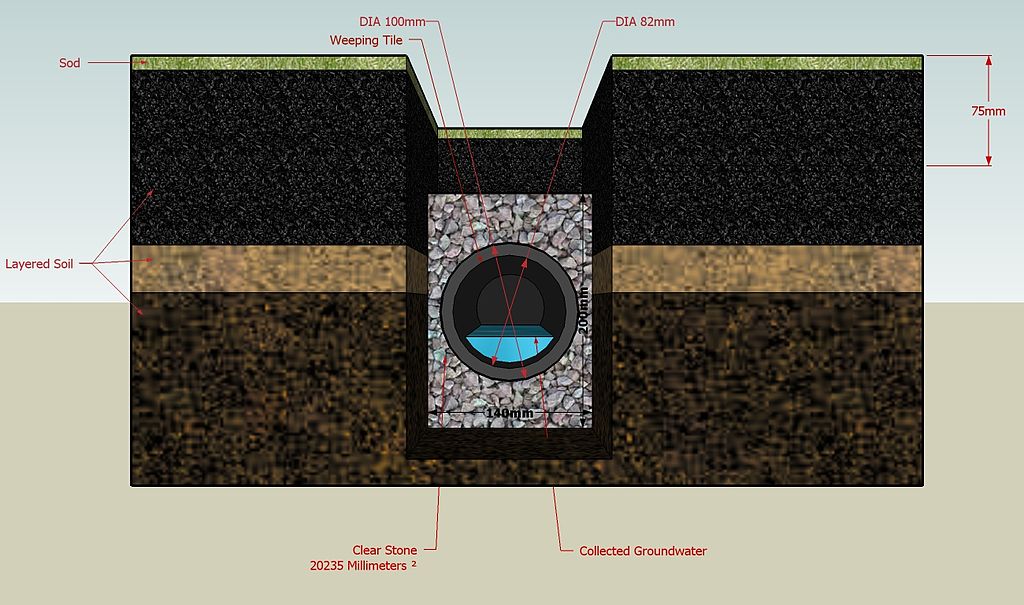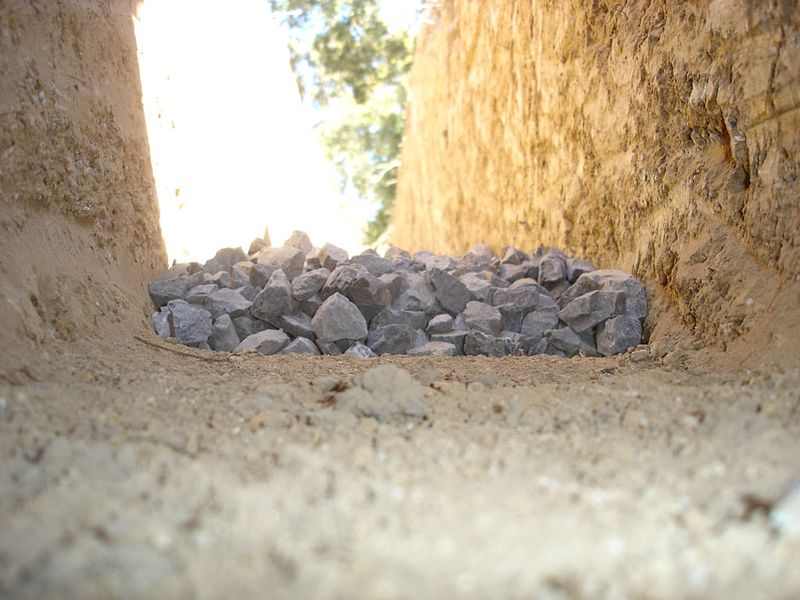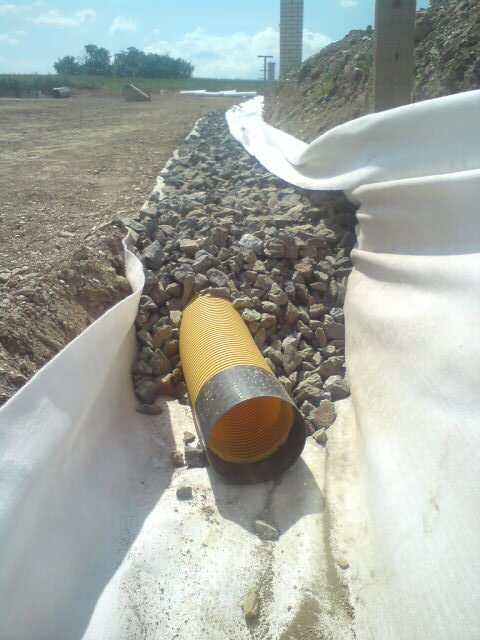A French drain might be the answer if you’re looking for a reliable way to keep your finished basement dry. A drainage system known as a French drain is made to collect water and direct it away from your house. In this article, we will explore what a French drain is, how it works, how it can be installed & benefits of French Drain in a finished basement.
What is a French Drain?

A drainage system called a French drain, also referred to as a weeping tile, is made to collect excess water and direct it away from the foundation of your house. It consists of a trench filled with gravel or rock in the middle of which is positioned a perforated pipe. Filter fabric is frequently used to cover the trench in order to keep debris out of the system.
How Does a French Drain Work?
By diverting water away from your home’s foundation, a French drain is an efficient way to stop water damage. However, how precisely does a French drain operate?
A French drain diverts groundwater away from your house by gathering it after it has seeped into the ground. The drain consists of a trench filled with gravel or rock that is cut through the middle by a perforated pipe. This pipe is intended to gather groundwater seepage and direct it away from the foundation of your house.
The water can freely flow through the gravel or rock in the trench and into the pipe in the middle, where it is collected and removed from your home by gravity or a sump pump. By doing this, you can guarantee that any water that has seeped into the ground around your house is effectively directed away, avoiding the risk of it collecting near your foundation and resulting in water damage.
A French drain uses gravel or rock as well as a filter fabric to keep debris from clogging the system. This material is positioned over the gravel or rock in the trench to prevent any obstructions from getting in the way of water flow. Additionally, the filter material works to keep dirt out of the system, which can cause clogs and prevent the drain from functioning properly.
Signs You Need a French Drain in Your Finished Basement
If your basement is finished, you are probably already aware of the potential problems that can result from water damage. In addition to requiring expensive repairs, it can also put your health at risk due to the growth of mold and mildew. Fortunately, preventing water damage in your finished basement can be accomplished with the help of a French drain.
There are a few indicators that a French drain installation is necessary to stop water damage. Water stains on walls or floors are one of the most typical symptoms. These stains can show up as a visible water line on the walls or floor, as discoloration or bubbling of paint or wallpaper, or both. It’s crucial to look into any of these symptoms if you notice them.
Mold growth or musty odors are additional indicators that a French drain installation may be necessary. These may be brought on by an abundance of moisture in the air, which may encourage the development of mold and mildew. This can not only be unsightly but also be harmful to your health, especially if you have allergies or respiratory problems.
Another indication that you need a French drain installed are cracks in the foundation. Your basement may become wet through these cracks, which over time may cause significant water damage. Furthermore, peeling wallpaper or paint may indicate an excess of moisture in the air, which can be remedied by installing a French drain.
Another indication that you need a French drain is damp or humid air in your finished basement. The installation of a French drain can effectively address this issue, which may be brought on by an excessive amount of moisture in the air. Furthermore, puddles or standing water in your basement may indicate that water is seeping in through the foundation, which can be fixed by installing a French drain.
In conclusion, there are a number of indications that you might require the installation of a French drain in your finished basement, such as water stains, musty odors or mold development, cracks in the foundation, peeling paint or wallpaper, damp or humid air, and standing water or puddles. It’s crucial to take action if you notice any of these symptoms.
Factors to Consider Before Installing a French Drain in Your Finished Basement
There are a few key considerations to make before starting the project if you’re thinking about installing a French drain in your finished basement.
The seriousness of the water problem is one of the most important factors to take into account. A French drain might be required if you have a serious issue with water infiltration, such as standing water or puddles in your basement, in order to stop further water damage. Alternative approaches, on the other hand, might be more suitable if the water problem is not as serious.
The type of soil surrounding your home is a crucial additional consideration. The effectiveness of a French drain can be impacted by the permeability of different soil types, which varies. For instance, clay soil can make it more difficult for water to move through the system because it is less permeable than sandy soil.
When installing a French drain, the position of utilities and other obstacles is also crucial to take into account. During the installation process, it’s crucial to avoid damaging utility lines or other obstacles as this could result in expensive repairs and delays.
Another important consideration is the slope of the ground. To ensure that water flows properly away from your home, a French drain needs a slope. If your house is relatively flat, the installation process may be more challenging and require additional measures to ensure proper water flow.
The size of your basement is a crucial factor to take into account when installing a French drain, to sum up. In order to effectively prevent water damage, the size of the drain system will depend on the size of the basement, and a larger basement may need a more extensive system.
Before installing a French drain in your finished basement, you must speak with a qualified contractor. A specialist can assess your particular circumstance and suggest the best answer to meet your needs. You can make sure that a French drain installation will be successful and effective in preventing water damage to your finished basement by taking into account these crucial factors and consulting with a professional.
Tools and Materials You Will Need for Installing a French Drain in Your Finished Basement
To install a French drain in your finished basement, you will need several tools and materials. These include:
- Shovel or excavator: You will need a shovel or excavator to dig a trench along the perimeter of your basement where you plan to install the French drain.
- Level: A level is necessary to ensure that the trench is dug evenly, so the water flows properly.
- Tape measure: You will need a tape measure to measure the length and depth of the trench accurately.
- Perforated pipe: The perforated pipe is the essential component of the French drain system. It collects the water and transports it away from your home. Be sure to choose a pipe that is appropriate for your specific situation and the size of your basement.
- Gravel or rock: The gravel or rock is used to fill the trench and create a channel for water flow. It allows water to move freely through the system while also preventing debris from clogging the pipe.
- Filter fabric: The filter fabric is used to wrap the perforated pipe, preventing dirt and debris from entering the system and clogging the drain.
- Sump pump (if necessary): If your basement is below the water table, you may need a sump pump to move water out of the trench and away from your home.
- Drainage fittings: You will need drainage fittings to connect the perforated pipe and sump pump to the drainage system.
- Cement or mortar (if necessary): If the basement walls or foundation have cracks or holes, you may need to seal them with cement or mortar to prevent water from entering the basement.
It is essential to have all the necessary tools and materials before beginning the installation process. By having everything you need, you can ensure that the installation process goes smoothly and effectively, protecting your finished basement from water damage.
Step-by-Step Guide to Installing a French Drain in Your Finished Basement
Installing a French drain in your finished basement can be an effective way to prevent water damage. Here is a step-by-step guide on how to install a French drain:
Step 1: Prepare the area
Before you start digging, clear the area around the perimeter of your basement. Move any furniture, appliances, or other items that could get in the way of the installation process.
Step 2: Dig the trench
Using a shovel or excavator, dig a trench around the perimeter of your basement. The trench should be deep enough to allow for proper water flow and at least 6 inches wide.
Step 3: Check the slope
Use a level to ensure that the trench is dug evenly, with a slight slope away from your home to allow for proper water flow.
Step 4: Install the perforated pipe
Place the perforated pipe in the center of the trench. Be sure to choose a pipe that is appropriate for your specific situation and the size of your basement. Connect the drainage fittings to the pipe.
Step 5: Fill the trench with gravel or rock
Fill the trench with gravel or rock, ensuring that the perforated pipe is completely covered. The gravel or rock will create a channel for water flow, allowing water to move freely through the system while also preventing debris from clogging the pipe.
Step 6: Wrap the pipe with filter fabric
Wrap the perforated pipe with filter fabric, securing it with zip ties or duct tape. The filter fabric will prevent dirt and debris from entering the system and clogging the drain.
Step 7: Install the sump pump (if necessary)
If your basement is below the water table, you may need to install a sump pump to move water out of the trench and away from your home. Connect the sump pump to the perforated pipe and the drainage system.
Step 8: Seal any cracks or holes
If the basement walls or foundation have cracks or holes, seal them with cement or mortar to prevent water from entering the basement.
Step 9: Test the system
After installation, test the French drain system by pouring water into the trench. Check to see that the water is flowing properly and that there are no leaks or blockages.




By following these steps and using the necessary tools and materials, you can effectively install a French drain in your finished basement, protecting it from water damage.
Common Mistakes to Avoid When Installing a French Drain in Your Finished Basement
When installing a French drain in your finished basement, it is crucial to avoid common mistakes that can compromise the effectiveness of the drainage system. Here are some common mistakes to avoid:
- Failing to slope the trench away from the foundation: One of the most common mistakes is not sloping the trench away from the foundation. If the trench is not sloped, water may not properly flow through the system, resulting in water damage to your basement. Ensure that the trench has a slight slope away from your home to allow for proper water flow.
- Using the wrong size or type of perforated pipe: Choosing the wrong size or type of perforated pipe can also be a mistake. The pipe must be appropriate for your specific situation and the size of your basement. It is essential to consult with a professional contractor to determine the right type of pipe for your situation.
- Filling the trench with soil instead of gravel or rock: Filling the trench with soil instead of gravel or rock is another common mistake. Soil is not suitable for creating a channel for water flow, and it can easily clog the perforated pipe, rendering the system useless. Always fill the trench with gravel or rock, as it creates a channel for water flow and prevents debris from clogging the pipe.
- Neglecting to install a sump pump, if necessary: If your basement is below the water table, neglecting to install a sump pump can be a mistake. A sump pump is necessary to move water out of the trench and away from your home. Failure to install a sump pump in such situations can result in water damage to your basement.
- Forgetting to seal any gaps or cracks in the foundation: Finally, forgetting to seal any gaps or cracks in the foundation is a common mistake. Even the smallest gaps or cracks can allow water to enter your basement, making the French drain system useless. Seal any gaps or cracks with cement or mortar to prevent water from entering the basement.
By avoiding these common mistakes, you can effectively install a French drain in your finished basement, protecting it from water damage. It is essential to consult with a professional contractor to ensure that the installation process goes smoothly and effectively.
Maintenance Tips for Your French Drain in Your Finished Basement
Maintaining your French drain system is important to ensure it continues to protect your finished basement from water damage. Here are some maintenance tips to keep in mind:
- Regular Inspections: Regularly inspect the French drain system for any damage or clogs. Check the trench and perforated pipe for any signs of damage, such as cracks or leaks. Also, ensure that the trench is clear of any debris or sediment buildup that could block water flow.
- Cleaning the System: If you notice any buildup of debris or sediment in the system, clean it out as soon as possible. Use a garden hose or pressure washer to flush out the system and remove any blockages.
- Check the Sump Pump: If your French drain system includes a sump pump, make sure it is working properly. Check the pump’s float switch to ensure it turns on and off correctly. Additionally, ensure the pump’s discharge pipe is clear of any debris or blockages.
- Install a Backup Power Source: In case of power outages, consider installing a backup power source for your sump pump. This could be a battery backup or a generator that kicks on automatically when the power goes out. This ensures that your sump pump can continue to function even during power outages, preventing potential water damage.
By following these maintenance tips, you can ensure that your French drain system continues to function properly, protecting your finished basement from water damage.
Benefits of Installing a French Drain in Your Finished Basement
Installing a French drain in your finished basement can provide several benefits that can make it a worthwhile investment. Here are some of the key benefits to consider:
- Preventing Water Damage and Mold Growth: One of the main reasons to install a French drain in your finished basement is to prevent water damage and mold growth. By directing water away from your home’s foundation and basement walls, you can avoid moisture buildup that can lead to water damage and mold growth. This can help protect your home’s structural integrity and prevent costly repairs.
- Improving Air Quality and Reducing Humidity Levels: Water damage and mold growth can also lead to poor indoor air quality and high humidity levels. By installing a French drain, you can reduce the amount of moisture in your basement and improve air circulation. This can help reduce the risk of respiratory problems and allergies, as well as prevent musty odors.
- Protecting Your Home’s Foundation from Water Damage: Water can be very damaging to your home’s foundation over time, leading to cracks, shifting, and settling. By directing water away from your home’s foundation, a French drain can help protect it from water damage and extend its lifespan.
- Increasing the Value of Your Home: Installing a French drain in your finished basement can also increase the value of your home. Potential buyers will see it as a valuable investment in protecting the home from water damage and improving indoor air quality. This can make your home more attractive to buyers and potentially increase its resale value.
Overall, installing a French drain in your finished basement can provide several benefits that can make it a smart investment for protecting your home and improving its value.
Conclusion
In conclusion, a French drain can be an effective way to prevent water damage in your finished basement. By following the steps outlined in this guide and consulting with a professional contractor, you can install a French drain that will protect your home for years to come.
Image Source @ Wikipedia

